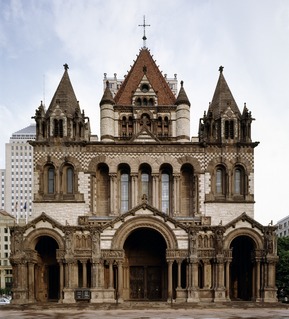
Richardsonian Romanesque is a style of Romanesque Revival architecture named after the American architect Henry Hobson Richardson (1838–1886). The revival style incorporates 11th and 12th century southern French, Spanish, and Italian Romanesque characteristics. Richardson first used elements of the style in his Richardson Olmsted Complex in Buffalo, New York, designed in 1870. Multiple architects followed in this style in the late 19th century; Richardsonian Romanesque later influenced modern styles of architecture as well.

William Bunker Tubby was an American architect who was particularly notable for his work in New York City.

The Salem Downtown Historic District is a national historic district located at Salem, Washington County, Indiana. The original plat of the town, founded in 1814, is within the district. It is bounded by Mulberry and Hackberry Street in the north, Hayes Street in the east, the CSX railroad tracks in the south, and Brock Creek to the west. It encompasses 253 contributing buildings, 3 contributing structures, and 5 contributing objects in the central business district of Salem. The district was placed on the National Register of Historic Places in 1997. Its architectural styles are Italianate, Gothic Revival, Classical Revival, Late Victorian, Early Republic, and Late 19th/20th Century Revivals.
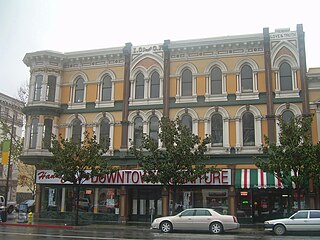
The Downtown Historic District of San Jose, California is a designated U.S. Historic District area of the city roughly the size of one square block. It is bounded by S. First Street to the west, E. San Fernando Street to the south, S. Third Street to the east, and E. Santa Clara Street to the north, but also includes the south side of E. Santa Clara Street between Third and Fourth Streets.

The Bank of Bigheart is a historic commercial building in the town of Barnsdall, Oklahoma. It originally housed the first bank in Barnsdall, which was originally named Bigheart, Oklahoma. The building was added to the National Register of Historic Places on November 23, 1984.

The Downtown New London Historic District, also known as the Waterfront Historic District, refers to 78 acres (32 ha) with 223 contributing buildings along the waterfront of New London, Connecticut. It was added to the National Register of Historic Places (NRHP) in 1979, with 190 buildings and 60 acres (24 ha). The district was expanded in 1988, adding 18 acres (7.3 ha) and 33 buildings.
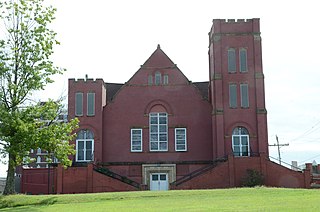
The First Baptist Church is a historic church building in Muskogee, Oklahoma. The church was built in 1903 and was the first church building for the African-American population of Muskogee County. It was built in a Romanesque Revival style. It features two asymmetrical, crenelated towers and a steeply pitched gabled roof. The build is clad in two types of red brick. The two types of brick are separated by a rusticated limestone belt course. The building was listed on the National Register of Historic Places in 1984 for architectural significance and for its importance in local African-American history.
The Osage Bank of Fairfax was the first bank building built in Osage County. It was built in 1904, at the time of the Oklahoma oil boom. It is one of four small bank buildings built in Richardsonian Romanesque style in Osage County, Oklahoma during 1904–1911. The others are Bank of Hominy, Bank of Burbank, and Bank of Bigheart.

Edward Townsend Mix was an American architect of the Gilded Age who designed many buildings in the Midwestern United States. His career was centered in Milwaukee, Wisconsin, and many of his designs made use of the region's distinctive Cream City brick.
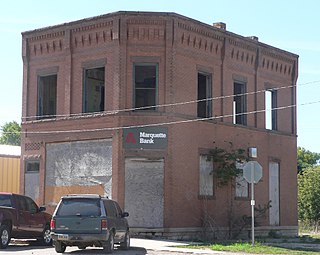
The First State Bank Building in Revillo, South Dakota was built in 1905. It was listed on the National Register of Historic Places in 1987.

The I.O.O.F. Building is a building in Idaho Falls, Idaho, United States. It was built in Romanesque Revival style in c.1909, and served historically as a clubhouse for the local International Order of Odd Fellows chapter, which was formed by 1892.

The Downtown Athens Historic District is a historic area in the Downtown Athens neighborhood of Athens, Georgia. It was listed on the National Register of Historic Places in 1978. Its boundaries were revised twice, in 1984 and 2006, and additional documentation was filed in 2006.

Lackawanna County Courthouse is a historic courthouse building located in Scranton, Lackawanna County, in the U.S. state of Pennsylvania.

Chief Justice Joseph M. Beck House is a historic building located in Fort Madison, Iowa, United States. It was individually listed on the National Register of Historic Places in 1984. In 2014 it was included as a contributing property in the Park-to-Park Residential Historic District.
Mitchell Downtown Historic District is a national historic district located at Mitchell, Lawrence County, Indiana.

State Savings Bank is a historic building located in Quasqueton, Iowa, United States. It was originally built as a three-story warehouse and commercial sales building in 1852. In 1902 it was significantly altered. The building was reduced to two stories, and it was given a completely new facade in the Romanesque Revival style. Since that time it has housed a bank and a series of retail stores. The building thought to be unique in Buchanan County in that its facade is completely composed of brick, while other Romanesque Revival commercial buildings have store fronts of cast iron, wood, and glass. It was listed on the National Register of Historic Places in 1999.
The Frankfort Commercial Historic District in Frankfort, Kentucky is a 24 acres (9.7 ha) historic district which was listed on the National Register of Historic Places in 1979. It included 86 contributing buildings and one contributing structure.

The Soldiers and Sailors Memorial Gymnasium, on the campus of Union College in Barbourville, Kentucky, was listed on the National Register of Historic Places in 1984.
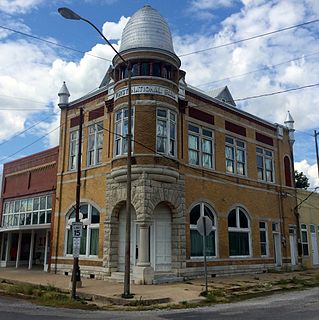
The First National Bank Building in Stratford, Oklahoma, at 100 West Main, was built in 1907. It was listed on the National Register of Historic Places in 2001.
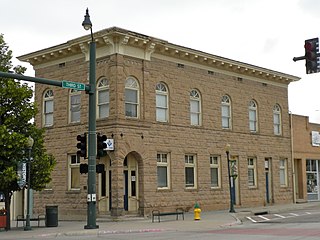
The First National Bank of Douglas County, at 300 Wilcox St. in Castle Rock, Colorado, in Douglas County, Colorado, was built in 1904. It was listed on the National Register of Historic Places in 1995.



















